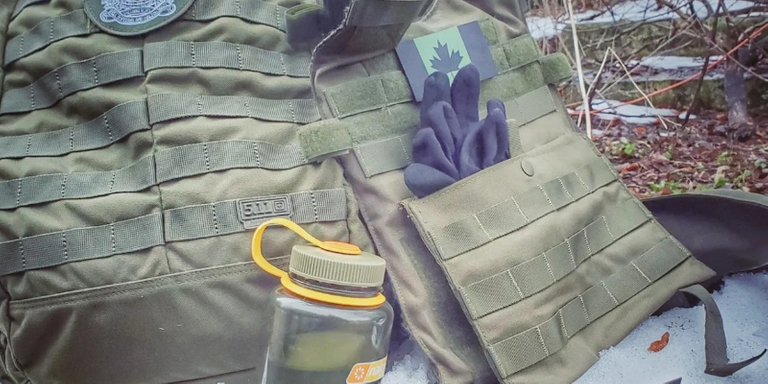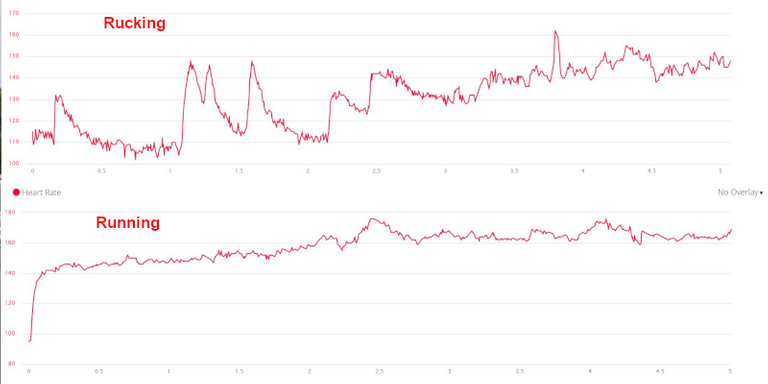What the heck is RUCKING and how do you start?
Everyone has probably already done it you just probably called it something else - like backpacking or hiking - let's take it up a notch and move to rucking as a fitness regime.

What the heck is rucking?
If you have ever been in the military you know exactly what rucking is. Depending on where you are from you may have called it going for a "ruck", a "tab" or a"Yomp". Yomp is actually an acronym for Your Own Marching Pace... Ya, take that with a grain of salt as we all know that's a misnomer - if someone is to your front you are going too slow ;-)
At its base rucking is just walking with additional weight - essentially loaded movement. Typically wearing a backpack or as I'll call it a rucksack or ruck. Again depending on where you are from it's a ruck, backpack, bergen, day-bag(smaller backpack), patrol pack and so on. Essentially any system that adds weight to your walk. Might even be a plate carrier with weighted plates or a combination of ruck/backpack and plate carrier.

Why ruck?
The number one reason is it's hella good for you. Better than running, for some. Ok, ok, before all the runners jump on me - I run too. But you'll burn close to 3 times the calories than a regular walk and it's much easier on the joints(in most cases). Rucking works everything, legs, back, core and cardio. And it's scalable, as you get stronger, you can up the weight, or increase your pace, go a longer distance or any combination of the three.
When you add that extra weight you will push your heart rate into the same zone that you would if you were out for a jog. So for me, I would rather ruck for 1.5 hours over jogging both my cardio and knees agree.
Check this out side-by-side heart rates (rucking vs running)

As you can see rucking gets your heart rate up there as well and stays up there once you get going.
What do you need to start?
Honestly, you don't need a heck of a lot to start out. Some sort of ruck, shoes suitable for the terrain and whatever you wear for exercising for your climate. Oh, and obviously something to add weight to your ruck. What you put in your ruck for weight is up to you. Just stuff around the house should do.
If you have dumbbells, kettlebells, weight plates, chains - word of warning some type of weight will dig into your back unless they are well padded - or things like water bladders, water bottles or jugs - another word of warning, liquids can slosh around and could destabilize you or your ruck. Other things could be books, reams of paper, bags of rice, dog food, flour, sand. Regardless of what you put in your ruck test it out to make sure you do not have anything digging into your back. If you don't test a few klicks in it will definitely suck.
If you are just starting out don't exceed 10-15% of your body weight. A good rule of thumb is to up it in 5-10 lb increments as you progress. Too light and you might as well just jog, too heavy and you risk injury and/or you're going to have to fall out early.
Ready to go!
Now that you are loaded out and eager to get going now what? That's basically it. Oh, one more thing. Hydration. You are going to be exerting yourself more than just a normal walk. Take enough water to ensure you maintain your hydration levels. Also, if you have a tracker app, your phone or a watch make sure you set that. Initially head out for a 30-minute ruck and see how things are going. Feeling good, bump it up to an hour. You'll want to maintain a consistent pace so that you can gauge progress.
Progress in rucking is measured in several ways. Increased distance, increased load or increased pace. I would caution against upping all three at once. Distance and load are by far the easiest to increase. The pace is a pretty tough one to up. Unless you can increase your stride drastically you can't really increase your pace unless you adopt the shuffle or a run.
N.B. BUUUUUUUTTT the shuffle and running is for experienced ruckers. Really. You do it wrong or your body is not ready you will blow your knees or injure yourself in some other way.
Instead of shuffling or running and killing your joints try to sustain a specific pace for a period of time, adjust your gait and style to support your pace and listen to your body.
Feel the burn
Give yourself time to recover. Don't ruck more than 2-3 times a week. If you are just starting out you will have sore legs a day or two after. Mostly normal. Again, you should pay attention to your body but you will feel like you just knocked out 100 squats. Feel the burn! It's a good pain. :-)
So add rucking to your workout now!
Join the Rucking Community Here
RUCK YEAH! That's right, there's now a community for Rucking so join it. Post your rucking stories. Share your success and failures. There's no judging and no running involved. RUCK ON!
Pop your questions into the comment below, after you join the community of course.
Hi @jasonbu - it's an interesting post. I haven't called it rucking but I do a lot of hiking. When I can't get out into the hills, I tend to pack up my rucksack to give myself more to carry and then walk and push my pace. I try to sustain a good pace as a form of workout. So this is similar to what you are describing.
That's exactly it. Sounds like you're already on the Rucking path and welcome to the community. Be sure to put a post together to show us your next ruck Ruck On!
Will do mate, although might not have a chance to go out for a couple of weeks, let's see.
Congratulations @jasonbu! You have completed the following achievement on the Hive blockchain and have been rewarded with new badge(s):
Your next target is to reach 69000 upvotes.
You can view your badges on your board and compare yourself to others in the Ranking
If you no longer want to receive notifications, reply to this comment with the word
STOPCheck out the last post from @hivebuzz:
So true. It took me about a week of test runs at about 5 miles each to get my pack load setup right. This was mostly due to a new frame being added into the mix, but through this I found just how important it was to mentally prepare myself for the possibility of a faulty load becoming problematic in the 3rd mile.
This is an awesome write up, not sure how I missed all the activity going on in here!
Lately my ruck is out in the shed - I have to dig it out to at least inventory and get weights over the winter, but I’d also love to get some cold miles in this year too!
Thanks! Stepping off with new kit is definitely one of those hit and miss things and you absolutely need to prep for it mentally.
Love rucking in the winter. The more extreme the better! But fantastic when you get those warmer, sunny days. Nothing like it and no bugs! 😎
I agree 100%! When I started recording my ruckloads and progress I was going out for 5 miles almost every night. Since then my wife has started to wonder what I’m up to so now I’m laying low for a while lol - I’m going to make it a goal to take a cold shower and get boots on ground one night this week!